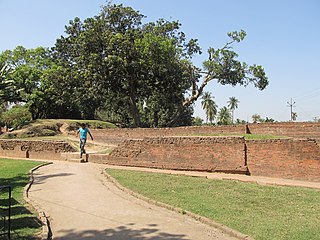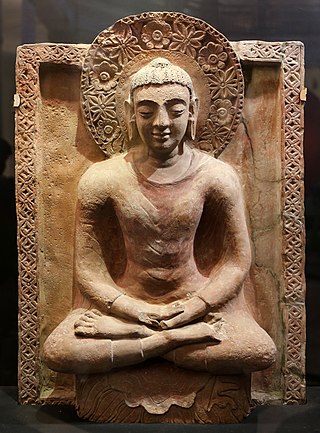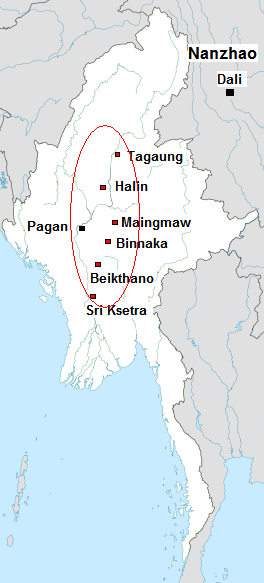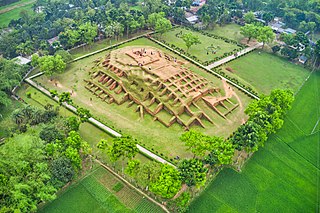
Chandraketugarh, located in the Ganges Delta, are a cluster of villages in the 24 Parganas district of West Bengal, about 35 kilometres (22 mi) north-east of Kolkata. The name Chandraketugarh comes from a local legend of a medieval king of this name. This civilization can perhaps be identified with the Gangaridai of Graeco-Roman accounts. In early historic times, Chandraketugarh was connected to the Ganga by the Bidyadhari River and must have been an important centre of trade and possibly also a political centre.
Sanghol is a historical village located in Fatehgarh Sahib District of Punjab, India dating to the Harrapan civilisation. It is also known as Uchha Pind Sanghol. It is about 40 km from Chandigarh on the way to Ludhiana and approximately 10 km from Dholewal. It is of archaeological significance. Excavations at the site have yielded coins and seals related to Toramana and Mihirakula belonging to central Asia. A Buddhist stupa was excavated in 1968, and in February 1985 117 carved stone slabs, including 69 pillars, 35 crossbars, figures and figurines, was excavated by the experts of the Directorate of Archaeology, Punjab. Scholars have said they are Kushan sculptures of the Mathura school of the 1st and 2nd centuries AD. They are in Sanghol Museum. Some of the art pieces from this museum sometimes go on display as special exhibits at various museums around the world.

Tamralipta or Tamralipti was an ancient port city and capital of Suhma kingdom in ancient India, located on the coast of the Bay of Bengal. The Tamluk town in present-day Purba Medinipur, West Bengal, is generally identified as the site of Tamralipti.

Kahu-Jo-Darro, also known as Mirpur Khas stupa, is an ancient Buddhist stupa found at the Mirpurkhas archaeological site in Sindh, Pakistan. The site is spread over 30 acres (120,000 m2). Excavations completed before 1910 revealed this large brick-based stupa and numerous terracotta reliefs now displayed in major world museums. The Mirpur Khas site is notable because historic Indian and Arab coins were found during its excavation. This has led scholars such as Derryl MacLean to suggest that Buddhism was thriving in Sindh region around the 10th-century and became extinct in these parts of the west and northwest South Asia after the Islamic conquest.

Somapura Mahavihara or Paharpur Buddhist Vihara in Paharpur, Badalgachhi, Naogaon, Bangladesh is among the best known Buddhist viharas or monasteries in the Indian Subcontinent and is one of the most important archaeological sites in the country. It was designated as a UNESCO World Heritage Site in 1985. It is one of the most famous examples of architecture in pre-Islamic Bangladesh. It dates from a period to the nearby Halud Vihara and to the Sitakot Vihara in Nawabganj Upazila of Dinajpur District.

Tilaurakot is a neighborhood in Kapilvastu Municipality in Kapilvastu District, in the Lumbini Province of southern Nepal. Previously it was a Village development committee. At the time of the 1991 Nepal census it had a population of 5684 people living in 944 individual households. It is situated 25 kilometers (15.5 mi) northwest of the Maya Devi Temple in Lumbini, and 4.5 kilometers (2.8 mi) southeast of Nigali Sagar in Nigalihawa.
Dihar is a village and an ancient archaeological site of great antiquarian importance brought into the limelight by Maniklal Sinha. Located in the Bishnupur subdivision of the Bankura district in the Indian state of West Bengal. It is 8 kilometres (5.0 mi) north of Bishnupur and is near Dharapat.

Jagajjibanpur or Jagajivanpur is an archaeological site in Habibpur block of Malda district in West Bengal state in eastern India. This site is located at a distance of 41 km east from English Bazar town. The most significant findings from this site include a copper-plate inscription of Pala emperor Mahendrapaladeva and the structural remains of a 9th-century Buddhist Vihara: Nandadirghika-Udranga Mahavihara.

Sri Ksetra, located along the Irrawaddy River at present-day Hmawza, was once a prominent Pyu settlement. The Pyu occupied several sites across Upper Myanmar, with Sri Ksetra recorded as the largest, the city wall enclosing an area of 1,477 hectares, although a recent survey found it enclosed 1,857 hectares within its monumental brick walls, with an extramural area of a similar size, being the largest Southeast Asian city before Angkor times. Issues surrounding the dating of this site has meant the majority of material is dated between the seventh and ninth centuries AD, however recent scholarship suggests Pyu culture at Sri Ksetra was active centuries before this.

Pundranagar in Paundrabhukti was the most important city in the ancient Bengal region, now identified with the current site of Mahasthan, located in Bogra, Bangladesh. It was a vibrant administrative, religious and cultural centre from the 3rd century BC to the 12th century AD that is from the Maurya Empire time to the Sena dynasty period. Archaeological remains and literary descriptions speak of a truly planned and magnificent city. City walls, elaborate gates, palaces, common dwellings, assembly halls, temples, viharas, shops, ponds and even suburban temples and viharas characterised the city; Chinese pilgrim, Xuanzang, visiting in the 7th century AD, particularly mentions ponds, orchards, flowers and pleasure gardens.

Pilak is an archaeological site in the Santirbazar sub-division of South Tripura district of the Indian state of Tripura. Many images and structures, belonging to Buddhist and Hindu sects, have been discovered here since 1927. The antiquities found here are dated to 8th to 12th centuries.

Moghalmari or Mogolmari is a village and an archaeological excavation site in the Dantan II CD block in the Kharagpur subdivision of the Paschim Medinipur district of West Bengal. The excavation of the site which began in 2002–03, led by Professor Ashoka Datta of Calcutta University has revealed the presence of a Buddhist monastery dated between 6th to 12th Century. A detailed excavation of the site started in November 2013 by the State Archaeological Directorate led to discovery of several artifacts and six tablets. Excavations at Moghalmari confirmed the presence of Buddhist vihars in the area, which was mentioned by Chinese travellers Fa Hien and Hiuen Tsang.

Gokul Medh is an archaeological site in Bangladesh. It is an excavated mound in the village of Gokul in Bogra Sadar Upazila, Bogra, about 2 km southwest of Mahasthangarh. It is also known as Lakshindar Medh, as it is known in folklore as the bridal chamber of Behula and Lakshinder, protagonists of a ballad. The mound served as the base of a Buddhist shrine or stupa built in the 7th century AD.

Sugh Ancient Mound, also known as the Ancient Site of Sugh, is located in the village of Amadalpur Dayalgarh, in the Yamunanagar district of Haryana, India. Suryamandir-Tirth in Amadalpur is nearby. Buddhist stupa here is identified with the Srughna.

Dhosa is a village, a gram panchayat and an archaeological site within the jurisdiction of the Jaynagar Majilpur police station in the Jaynagar I CD block in the Baruipur subdivision of the South 24 Parganas district in the Indian state of West Bengal.

Tilpi is a village and an archaeological site within the jurisdiction of the Jaynagar Majilpur police station in the Jaynagar I CD block in the Baruipur subdivision of the South 24 Parganas district in the Indian state of West Bengal.
Erenda was one of the southernmost sites of Neolithic and Early farming culture located in the coastal region of the Indian state of West Bengal. Construction of the settlement is believed to have started around 2000 BC.
Dihar is an archaeological site of Neolithic and Early village farming culture located in the Indian state of West Bengal. Construction of the settlement is believed to have started around 2700 BC. Dihar people developed a system of exploitation of natural resources and subsequent commercialization of commodities. The financial security afforded by this system encouraged artistic excellence in pottery making and bone-working.
Bharatpur is an archaeological site of Early village farming culture located in the Indian state of West Bengal. Construction of the settlement is believed to have started around 1735–1417 BC.
Debalgarh is an archaeological site located at Debagram Anulia village in Nadia district of West Bengal, India. Post-Gupta, Pala, Sena and Sultanate period artefacts have been recovered from the archaeological site, which representing an estimated 1500 years of history of the settlement. Debalgarh is believed to have been a trading center during the Sena period; Artistic excellence is observed in the pottery of this period.














